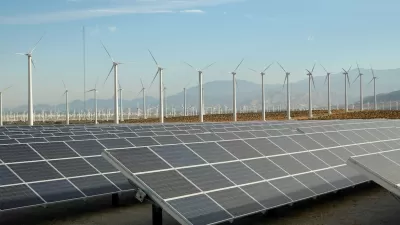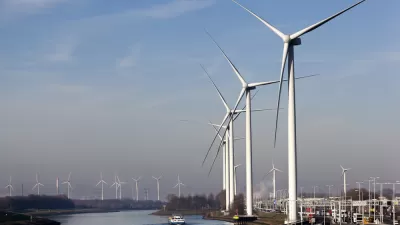The Southern California region is rich in renewable assets, so the LADWP is attempting to become the nationwide leader in developing and integrating wind power.
The article features remarks made by LADWP Senior Consultant James Caldwell, Jr. at the recent GreenXchange Global Marketplace Conference in Los Angeles:
"...today, wind produces roughly 1.5 percent of the U.S.'s electricity. I'm here to argue the proposition that we can and should generate roughly 20 percent of U.S. electricity with wind, within the planning horizon."
"the utility itself has a much more difficult role of aggregating all of these loads on the customer's side, and aggregating all of these energy sources on the supply side, and somehow making those meld in a way that keeps the lights on, keeps the clocks running at 60 cycles a second, and keeps the reliability that we know today. That's not going to be any easy transition."
"...the U.S. content of wind turbines is going to have to increase. We can't continue to import the cells from Europe, the blades from South America, towers from China, and expect to have the sort of economic development potential that we're going to need in order to get the political will to do this here and to contain the price pressures, given things like the Euro versus the dollar."
FULL STORY: LADWP’s James Caldwell: Siting,Transmission Present Obstacles for Robust Wind Portfolios

Planetizen Federal Action Tracker
A weekly monitor of how Trump’s orders and actions are impacting planners and planning in America.

Maui's Vacation Rental Debate Turns Ugly
Verbal attacks, misinformation campaigns and fistfights plague a high-stakes debate to convert thousands of vacation rentals into long-term housing.

San Francisco Suspends Traffic Calming Amidst Record Deaths
Citing “a challenging fiscal landscape,” the city will cease the program on the heels of 42 traffic deaths, including 24 pedestrians.

Amtrak Rolls Out New Orleans to Alabama “Mardi Gras” Train
The new service will operate morning and evening departures between Mobile and New Orleans.

The Subversive Car-Free Guide to Trump's Great American Road Trip
Car-free ways to access Chicagoland’s best tourist attractions.

San Antonio and Austin are Fusing Into one Massive Megaregion
The region spanning the two central Texas cities is growing fast, posing challenges for local infrastructure and water supplies.
Urban Design for Planners 1: Software Tools
This six-course series explores essential urban design concepts using open source software and equips planners with the tools they need to participate fully in the urban design process.
Planning for Universal Design
Learn the tools for implementing Universal Design in planning regulations.
Heyer Gruel & Associates PA
JM Goldson LLC
Custer County Colorado
City of Camden Redevelopment Agency
City of Astoria
Transportation Research & Education Center (TREC) at Portland State University
Jefferson Parish Government
Camden Redevelopment Agency
City of Claremont





























